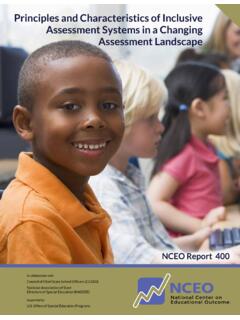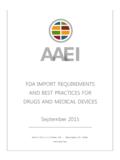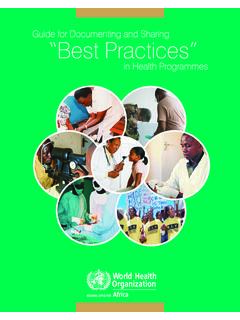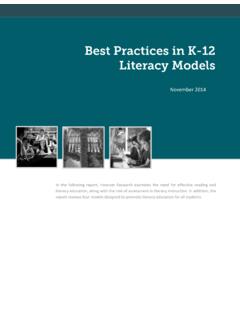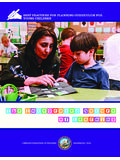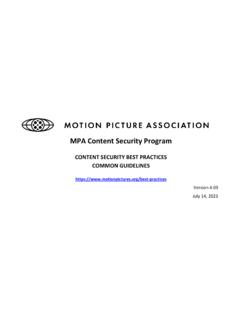Transcription of Computer-based Testing: Practices and Considerations
1 Synthesis Report 78 Computer-based Testing: Practices and ConsiderationsNATIONALC E N T E R O NEDUCATIONALOUTCOMESIn collaboration with:Council of Chief State School Officers (CCSSO)National Association of State Directors of Special Education (NASDSE)Supported Office of Special Education ProgramsSynthesis Report 78 Computer-based Testing: Practices and ConsiderationsMartha Thurlow Sheryl S. Lazarus Debra Albus Jennifer HodgsonSeptember 2010 All rights reserved. Any or all portions of this document may be reproduced and distributed without prior permission, provided the source is cited as:Thurlow, M.
2 , Lazarus, S. S., Albus, D., & Hodgson, J. (2010). Computer-based testing: Practices and Considerations (Synthesis Report 78). Minneapolis, MN: University of Minnesota, National Center on Educational Center on Educational OutcomesUniversity of Minnesota 207 Pattee Hall150 Pillsbury Dr. SE Minneapolis, MN 55455 Phone 612/626-1530 Fax 612/624-0879 University of Minnesota shall provide equal access to and opportunity in its programs, facilities, and employment without regard to race, color, creed, religion, national origin, gender, age, marital status, disability, public assistance status, veteran status, sexual orientation, gender identity, or gender document is available in alternative formats upon E N T E R O NEDUCATIONALOUTCOMESThe Center is supported through a Cooperative Agreement (#H326G050007)
3 With the Research to Practice Division, Office of Special Education Pro-grams, Department of Education. Additional support for targeted projects, including those on English language learners, is provided by other federal and state agencies. The Center is affiliated with the Insti-tute on Community Integration at the College of Education and Human Development, University of Minnesota. Opinions expressed herein do not necessarily reflect those of the Department of Education or Of-fices within it. NCEO Core StaffMartha L. Thurlow, Director Deb A. Albus Jason R. AltmanManuel T.
4 BarreraLaurene L. ChristensenChristopher J. JohnstoneJane L. Krentz Sheryl S. LazarusKristi K. Liu Ross E. MoenMichael L. MooreRachel F. QuenemoenChristopher RogersMiong VangYi-Chen WuExecutive Summary Computer-based testing (CBT) has emerged as one of the recent innovative approaches to assessments most pursued by states. CBT is lauded as the answer to having cheaper and speedier test delivery for state and district-wide assessments. It is also seen by some as an avenue toward greater accessibility for students with disabilities. In this report we explore the context of CBT, current state Computer-based tests, and Considerations for students with disabilities, in part as follow-up to a similar exploration that occurred in the early 2000s when just a few states were beginning to develop and implement CBT for their state assessments.
5 Nine Considerations for states and districts are presented: Consider the assumptions and beliefs of various stakeholders about Computer-based instruction and assessments. Consider the system as a whole, from the computer infrastructure to classroom and instructional experiences with computers before deciding whether and how to use CBT. Consider the computer or online platform first, with input from individuals who know students with disabilities and their accessibility needs. Consider a process for bringing in the needed expertise to delineate the specific accessibility fea-tures of CBT, and to determine what specific accommodations may still be needed by students with disabilities, as well as to determine whether a Computer-based test may create new accessibility issues.
6 Determine the policies for which accessibility features will be available to all students and which are designated for specific groups of students, such as students with disabilities. Consider how to track the use of accessibility features incorporated into CBT design. Field test the accessibility features of the Computer-based test at the same time that the Computer-based test is field tested. Examine results from CBT for students with disabilities to determine whether there are any features or characteristics of the assessment that might need reconsideration. Develop training for teachers and students to ensure that students benefit from accessibility of Contents Overview.
7 1 Contextual Issues Related to Computer-based Testing ..2 Technological Capacity in Schools ..2 universal Design Applied to CBT ..3 Perceived Advantages and Challenges of CBT ..4 Current Federal Programs that Promote CBT ..4 Analysis of States Computer-based Tests ..5 Regular Assessment ..6 End of Course Exams ..9 Discussion and Considerations ..10 Conclusions ..15 References ..16 Appendix A: Advantages and Challenges of Computer-based Tests (CBTs) ..21 Appendix B: Computer-based Tests: Specifications and Details ..31 Appendix C: Web Sites used in Analysis of States Computer-based Tests.
8 411 NCEOO verview Computer-based testing (CBT) has become widespread in recent years. Some states now use an online platform as the primary delivery mode for one or more Computer-based tests used for accountability purposes. When CBT was emerging in state testing in the early 2000s, Thompson, Thurlow, Quenemoen, and Lehr (2002) examined the implications of CBT for students with disabilities. There was not much literature about the use of CBT for large-scale assessments at that time, and Thompson et al. worked with states to explore what needed to be considered during development for students with disabilities and how states might address the needs of these students for accommodations in a CBT the early 2000s, much has occurred in CBT.
9 CBT seems to have advantages over paper and pencil testing, both for states that run the assessment programs and for the students who participate in them. These advantages are recognized by the Department of Education, which in one of its major initiatives (Race to the Top Assessment Program), encouraged the development of CBT. There currently is strong interest in CBT and advocates have identified many positive merits of this approach to assessment including: efficient administration, stu-dent preference, self-selection options for students, improved writing performance, built-in accommodations, immediate results, efficient item development, increased authenticity, and the potential to shift focus from assessment to instruction ( , Becker, 2006; Salend, 2009; Thompson et al.)
10 , 2002). CBT also allows new ways of assessing students that move beyond the traditional multiple choice and constructed response items. For example, innovative as-sessments are now being developed that enable students to manipulate data and role play. Yet, as states move forward with CBT they are discovering that it is important to consider not only the positive benefits, but also potential negative unintended consequences. These include, for example, the possibility that additional training will be needed for students with disabilities to interact successfully with computers and the challenges of determining the best way to present some accommodations such as screen readers.



